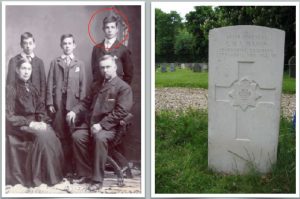14th Infantry Works Company, Devonshire Regiment

There is very little information appears to be available on Charles Mason’s military career other than the circumstances which led to his death.
Charles Henry James Mason was born at North Cerney on 26 September 1886 and he was baptised in the parish church on 7 November of that year. His parents were Henry James Mason (1861-1937) and his wife Sarah Ann Williams (1855-1913).
Henry Mason’s occupation, as noted in the baptismal record was a mason and parish clerk. In subsequent census returns he is shown as a builder. The couple had two other sons, Herbert Robert (born 1888) and Walter John (born 1891).
The 1911 Census shows Charles as living with his parents in North Cerney and he was employed as a carpenter and joiner.
It is not known when he joined the Army: he was most likely conscripted under the Military Service Act of that year. It would appear that he was posted to a Works or Labour Battalion of the Devonshire Regiment.
According to The Keep Military Museum website the 14th (Labour) Battalion was raised in the summer of 1916; it only had a tenuous connection with the Devons, as one or two invalided officers had served with them. Men in such battalions were unfit for front line service, due to wounds, ill health (or insufficient fitness) but sometimes undertook arduous, occasionally dangerous, support jobs behind the lines. Charles’ skills in carpentry and joinery were probably considered useful in this context.
The is no evidence to suggest that Charles served abroad and when the initial Works units transferred to the Labour Corps he was probably attached to one which was designated for home service.
His final days in the Army were described in a piece which appeared in the Cheltenham Chronicle of 28 April 1917. It stated that he was a private in the Devons who had come home on a week’s furlough . On Wednesday 18 April he had wished to give a hand at his former workplace and went to Bagendon Rectory where outside painting was taking place on the upper windows. This required the use of a ladder and Mason erected one at a long slope and ascended to a height of 25 feet when it broke. He fell to the ground, landing on his shoulder and head and may have struck a protruding balcony.
Another workman witnessed his fall and gave on the spot first aid. Mason was taken to Cirencester Hospital, where he was diagnosed as having concussion of the spine.
He died at the hospital a week later, on 25 April, aged 30. An inquest found that the cause of death was ‘pneumonia, consequent upon paralysis, due to a fracture of the spine’.
His burial took place three days later and a standard CWGC headstone now marks his grave in the churchyard of All Saints, North Cerney. He is commemorated on the 1914-18 War memorial panels inside the church.
Researched by Graham Adams 12 January 2021
